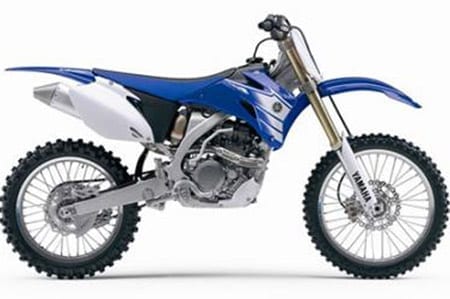The Polaris Outlaw
By TMX Archives on 28th Sep 06

Beauty and the beast . IN amongst the literature received along with the Polaris Outlaw was a leaflet that posed three questions: Are you a Hell Raiser? Are you a Rule Breaker? Are you an Outlaw? I had to be honest, and answered 'no' to all three. As a thirty-something, reasonably law-abiding bloke, perhaps I'm not really wayward enough for Polaris' latest high-performance ATV. Ah well, it takes all kinds...
The Outlaw itself flies through the bad-behaviour questions, answering 'yes' to all three. It is a hell-raiser with a 500cc engine taken from the Predator. It is also a rule breaker, being the first sports ATV to feature independent rear suspension. The 2006 Polaris Outlaw promises to offer a totally new riding experience.
The looks are decidedly similar to the Predator. It shares the same beady-eyed, twin-headlight stare, with a short, beak-like nose flanked by angular front mudguards - raised like a pair of mandibles waiting to bite into some unsuspecting prey. These vicious-looking fenders are more angular and sharper than the Pred's. The black bodywork, with its red and silver tattoo-style graphics, adds to the sinister image.
When you walk around the back of the Outlaw, you find yourself staring down the barrel of a single, centrally-mounted exhaust. At this point, the Outlaw really shows why it is a renegade. Instead of the usual solid-axle-and-swingarm arrangement found on the Predator (and every other sports quad), this is a set-up we're more used to seeing on top-end sports-utility models. The exposed back-end shows off its forged-aluminium lower control-arms, which look like spare parts from the Eiffel Tower! There are also upper control-arms, two half-shafts diverting the drive from the chain, and two shock-absorbers. Because of all this extra metalwork, the Outlaw weighs in at a shade under 200kg, which is about 11kg more than its cousin, the Predator.
To ride the Outlaw is initially a familiar experience. The dimensions, including the height, width and length, are shared with the Predator; the seat is one centimetre lower, and the exhaust note is every bit as raucous. The five-speed gearbox is a close-ratio affair, as per the Troy Lee Pred. There is also a reverse gear, utilised by operating a handlebar-mounted lever and kicking the gear lever down one more ratio.
The front-end of the Outlaw features the Pro steering system, which is designed to reduce the effects of bump-steer when the suspension is fully compressed. The front-wheel camber angles are almost totally unchanged over the full travel of the front shocks, whereas rivals in the 450 class can suffer variations of as much as four degrees.
One of the first things you notice on the Outlaw is the surprising amount of effort required to break traction and slide. Even when the back-end does start sliding, it seems to want to come back into line quite quickly. The Dunlop radial tyres, with their increased levels of lateral grip, may contribute to the slower slide rate, but the main reason for this behaviour is the independent rear suspension. The rear control-arms are tallied with a pair of Fox shocks, working together to pin the rear wheels to the deck. It takes more persuasion than expected to make the aluminium Douglas rear wheels shift sideways rather than driving forward. While a rigid-swingarm quad naturally pivots and over-steers, the Outlaw's rear tyres follow the contours of the ground, digging in and finding grip.
The advanced suspension set-up ensures a smooth, comfortable ride and this translates into more relaxed progress. On a conventional sports quad, hitting a bump with one rear wheel makes the whole back-end move or jump, temporarily interrupting drive. Moving swiftly across bumpy ground increases the frequency of these jolts and a rocking motion sets in. On the Outlaw, you can stay on the power, and the suspension takes care of everything.
After tuning into the unique riding characteristic of the Outlaw, I head off to have some fun. The location we have chosen for testing is the old chalk quarry of a redundant cement works. The terrain is extremely wet and the mud is at least six inches deep in places. Within minutes, the whole bike is covered in a thick layer of chalky sludge. I find it hard to move as I'm systematically plastered in the raw ingredients of Blue Circle's finest. When this lot dries out, I will be standing in ready-made concrete boots.
I find one of the lake-sized puddles and power through. It makes a useful drive-through car-wash. The Outlaw makes it through despite the deep water and thick silt which try to stop it. This is where I discover the down-side of the styling. Those front mudguards are just too narrow provide decent protection from spray. The Outlaw would be a superb Endurance racer, but, if you were racing on wet and muddy ground (i.e. at most events), you are going to get a face full of mud at every turn. It got so bad that my goggles were completely whitewashed and I couldn't see anything. It's not only the Outlaw that gets its rider muddy, of course, but it makes me wonder how endurance racers manage to ride around for three hours looking through two pounds of mud.
Essentially, the Outlaw is a Predator with independent rear suspension. Even though it is the same size as the Predator, it appears larger, and it's definitely more comfortable and relaxing to ride. It is never going to cut it in motocross circles but it should win a few fans in endurance. In the sport-leisure market, too, I think many will take to its more forgiving nature.
Polaris Outlaw - TECHNICAL SPECIFICATION
Engine type: 4-stroke, liquid-cooled, single cylinder, DOHC.
Displacement: 499cc.
Transmission: 5-speed (close ratio) with reverse
Drive: 2WD.
Front brakes: Dual discs, hydraulic.
Rear brakes: Single disc, hydraulic.
Front suspension: Dual A-arm, dual shocks;
254mm travel.
Rear suspension: PRO IRS, dual shocks; 254mm travel.
Front tyres: Dunlop Radial, 21 x 7 - 10.
Rear tyres: Dunlop Radial, 20 x 10 - 9.
DIMENSIONS
Overall length: 1,816mm.
Overall width: 1,207mm.
Overall height: 1,143mm.
Wheelbase: 1,283mm.
Seat height: 813mm.
Ground clearance: 279mm.
Dry weight: 199kg.
Fuel capacity: 12.3L.
RRP: £5,995
Specification:
